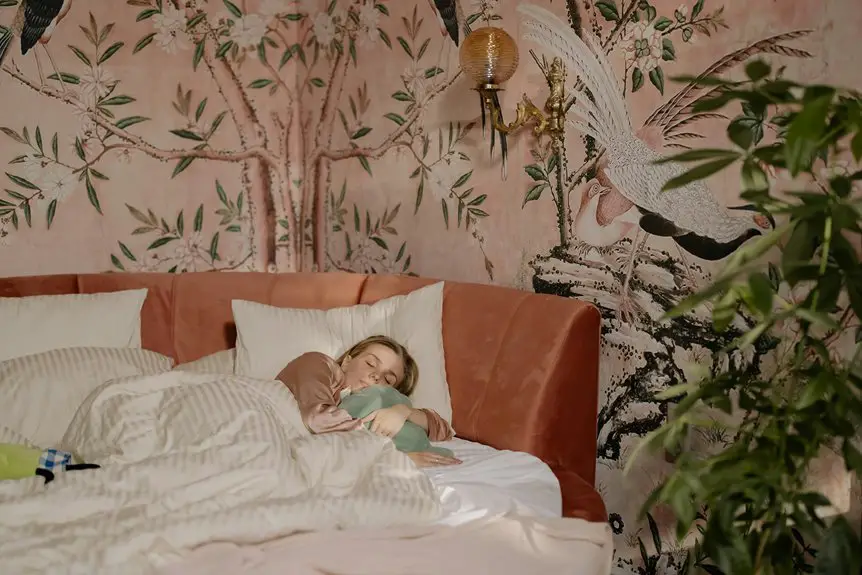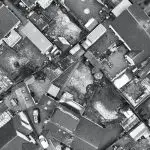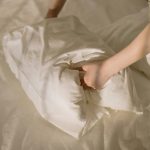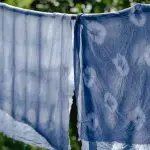You’ll need about two yards of fabric that’s 42 to 44 inches wide to make a king size pillowcase. A standard king pillow measures 20 by 36 inches, but you need extra fabric for seams and hems—usually adding around 1 inch on each side. This gives you enough fabric to comfortably cover the pillow with a proper fit. If you want to learn how to choose the best fabric and prepare it for sewing, keep exploring these tips.
Table of Contents
Key Takeaways
- A standard king size pillowcase requires fabric measuring approximately 20 inches by 72 inches, including seam allowances and hems.
- Add 1 inch on each side for seams and hems, totaling about 2 extra inches in both width and length.
- Use fabric widths of 42-44 inches (quilting cotton) or 54+ inches (home decor) to minimize waste and simplify cutting.
- Include extra fabric width if the pillow is fluffy to ensure a comfortable, non-tight fit.
- Pre-wash and iron fabric before cutting to prevent shrinking and ensure precise measurements.
Understanding King Size Pillow Dimensions
A standard king size pillow measures 20 inches by 36 inches, so you’ll want to keep those dimensions in mind when selecting fabric.
When making a pillowcase, you need to account for extra fabric for seams and hems, usually about an inch on each side. That means your fabric piece should be slightly larger than 20 by 36 inches.
Also, consider the pillow’s thickness; if it’s especially fluffy or thick, you might want to add extra width to accommodate the puff.
Remember, a snug fit looks neat, but you don’t want it too tight as it could stretch or stress the fabric.
Understanding these dimensions guarantees you cut the right amount and avoid wasting fabric or ending up with a poor fit.
Standard Fabric Widths to Consider
Since fabric comes in various standard widths, knowing these measurements helps you plan how much material to buy for your king size pillowcase.
Most quilting cottons and apparel fabrics come in widths of 42 to 44 inches, while home decor fabrics often measure 54 inches wide or more. Some specialty fabrics can be even wider, up to 60 inches.
Quilting cottons are typically 42–44 inches wide; home decor fabrics range from 54 to 60 inches wide.
When choosing fabric, you’ll want to take into account these widths because they affect how many pillowcases you can cut from a single length and whether you need to join fabric pieces.
Generally, a wider fabric can reduce waste and simplify cutting for larger projects like king size pillowcases.
Keep the fabric width in mind as you move forward, so you buy just enough without over-purchasing.
Calculating Fabric Length for Your Pillowcase
To calculate the fabric length for your king size pillowcase, start with the standard pillow dimensions and add seam allowances for a perfect fit.
Remember, seam allowances can vary, so factor in extra fabric for stitching.
Also, the fabric width you choose will affect how much length you actually need to cut.
Standard King Pillow Dimensions
Knowing the exact dimensions of a standard king pillow is essential when calculating how much fabric you’ll need for your pillowcase. A standard king pillow typically measures 20 inches by 36 inches.
When planning your fabric, you’ll want to account for both the front and back of the pillowcase, meaning you’ll need fabric that covers double the width plus the length. This translates to roughly 20 inches (height) by 72 inches (width) to cover both sides.
Keep in mind, this measurement guarantees your pillow fits snugly without excess fabric. By starting with these precise dimensions, you can avoid wasting fabric and create a pillowcase that fits perfectly.
Accurate measurements make your sewing project smoother and more efficient.
Seam Allowance Considerations
Although calculating the fabric size based on your pillow’s dimensions is essential, you also need to factor in seam allowances to guarantee a proper fit. Seam allowances are extra fabric margins sewn into the edges, ensuring your pillowcase isn’t too tight or too loose once stitched. Typically, a ½-inch seam allowance works well for pillowcases.
Here’s a quick guide to help you visualize how seam allowances affect your fabric needs:
| Pillow Size | Pillow Dimension (inches) | Seam Allowance (inches) |
|---|---|---|
| King Standard | 20 x 36 | ½ (all sides) |
| Total Fabric | 21 x 37 | Includes seam margin |
| Fit Result | Snug and comfortable fit | Seam allowance matters |
Fabric Width Impact
Fabric width plays a crucial role in determining how much length you’ll need for your king size pillowcase. If your fabric is wider, you’ll need less length because you can fit the pillowcase’s width across the fabric.
Conversely, narrower fabric means you’ll require more length to accommodate the full width of the pillowcase. Most standard fabrics come in widths of 42 to 45 inches or 54 to 60 inches, which influences how you cut your pieces.
For a king size pillowcase, which typically measures around 20 by 36 inches, choosing wider fabric allows you to cut the width across the fabric’s width, reducing waste.
Always check your fabric’s width before measuring length to guarantee you buy just enough fabric without overspending.
Adding Seam Allowances and Hems
When cutting your fabric, make certain to add standard seam allowances—usually about ½ inch—to each edge.
You’ll also want to factor in hem depth, typically around 1 to 2 inches, depending on your preferred finish.
Adjust your fabric measurements accordingly to guarantee your pillowcase fits perfectly once sewn.
Standard Seam Allowance Sizes
To sew a king size pillowcase successfully, you’ll need to add standard seam allowances and hems to your fabric measurements.
Seam allowances are the extra fabric you leave around the edges to join pieces together. For most home sewing projects, including pillowcases, a ½-inch seam allowance works well—it’s easy to sew and strong enough for everyday use.
When cutting your fabric, mark this allowance clearly to guarantee accurate stitching. Remember, consistent seam allowances keep your pillowcase symmetrical and prevent shrinking after washing.
Avoid narrower allowances unless you’re experienced, as they can weaken seams. By sticking to the standard ½-inch allowance, you’ll have precise edges ready to sew, making your king size pillowcase look professional and durable without extra hassle.
Hem Depth Recommendations
Along with seam allowances, you’ll want to account for the hem depth when cutting your fabric for a king size pillowcase. Typically, a hem depth of 1 to 2 inches works well to create a neat, durable edge. This measurement guarantees the fabric folds over enough to prevent fraying while maintaining a clean finish.
When planning your fabric, add this hem depth to both the width and length, depending on your pillowcase design. Keep in mind that a double-fold hem, which folds the fabric twice before stitching, requires extra fabric—usually twice the hem depth.
Factoring in the hem depth along with seam allowances helps you cut the right amount of fabric, avoiding surprises during sewing and guaranteeing a polished final product.
Adjusting Fabric Measurements
Although cutting fabric to the pillowcase’s exact dimensions might seem straightforward, you need to add seam allowances and hems to guarantee a proper fit and finish.
Typically, you’ll add about ½ inch for seam allowances on all sides. For hems, consider adding 1 to 2 inches on the opening side for a clean edge and durability.
For a king size pillowcase (usually 20 by 36 inches), start by adding 1 inch total for seams (½ inch each side) and then include the hem allowance on the opening side.
This means you’ll cut fabric roughly 21 inches wide by 38 inches long. Adjust these measurements based on your preferred hem depth and seam width to confirm the pillowcase fits perfectly and looks polished.
Choosing the Right Fabric Type
Since the fabric you choose affects both comfort and durability, you’ll want to contemplate the material carefully before buying. Cotton offers breathability and softness, perfect for year-round use. Linen feels cool and gets softer with each wash. Polyester is durable and wrinkle-resistant but less breathable. Bamboo is eco-friendly and naturally hypoallergenic.
| Fabric Type | Key Features |
|---|---|
| Cotton | Soft, breathable |
| Linen | Cool, softens over time |
| Polyester | Durable, wrinkle-resistant |
| Bamboo | Hypoallergenic, eco-friendly |
Think about your sleep preferences and maintenance ease when selecting fabric. This guarantees your king size pillowcase will feel great and last long.
Tips for Efficient Fabric Cutting
Cutting fabric efficiently can save you time and reduce waste when making your king size pillowcase. First, always pre-wash and iron your fabric to guarantee accurate measurements and smooth cutting.
Lay your fabric on a flat surface, aligning the grainline to keep your pillowcase durable and well-shaped. Use a rotary cutter and clear ruler for straight, precise cuts, especially when working with large pieces. Measure twice before cutting to avoid mistakes.
Align fabric grain and use a rotary cutter with a clear ruler for precise, mistake-free cuts.
Arrange your pattern pieces close together to maximize fabric use and minimize scraps. Keep your scissors sharp and designated for fabric only, so they cut cleanly.
Finally, label your cut pieces immediately to stay organized and speed up your sewing process. These tips will help you work smarter, not harder.
Preparing Your Fabric Before Sewing
After efficiently cutting your fabric, the next step is to prepare it properly before sewing your king size pillowcase. Start by washing and drying the fabric to pre-shrink and remove any chemicals. Then, iron the fabric to smooth out wrinkles, making it easier to measure and sew accurately. Finally, align the fabric edges and pin them to keep everything in place during sewing.
| Step | Action | Purpose |
|---|---|---|
| 1 | Wash & dry fabric | Pre-shrink & clean |
| 2 | Iron fabric | Remove wrinkles |
| 3 | Align edges | Guarantee proper shape |
| 4 | Pin fabric | Keep fabric secure |
| 5 | Double-check measurements | Avoid mistakes before sewing |
Frequently Asked Questions
Can I Use Pre-Washed Fabric for Pillowcases?
Did you know pre-washing fabric shrinks up to 10%? You can definitely use pre-washed fabric for pillowcases—it prevents future shrinkage, keeps colors vibrant, and makes your pillowcases softer and more comfortable right from the start.
How Do I Care for Homemade Pillowcases?
You’ll want to wash your homemade pillowcases gently in cold water and use mild detergent. Avoid bleach and high heat drying to keep fabric soft and colors vibrant. Iron on low if needed for a crisp look.
Are Pillowcases Suitable for Allergies?
Like a shield against dust, pillowcases can protect you from allergens if you choose hypoallergenic fabrics. You’ll want breathable, tightly woven materials that block dust mites and irritants to keep allergies at bay effectively.
Can I Add Decorative Trims to Pillowcases?
You can definitely add decorative trims to pillowcases. Just sew them securely along edges or seams to enhance style without affecting comfort. Choose trims that wash well and won’t irritate your skin for the best results.
How Long Does It Take to Sew a Pillowcase?
You’ll usually spend about 30 to 60 minutes sewing a pillowcase, depending on your skill level and the design complexity. Simple cases go faster, but adding trims or details might take extra time.
- Does Chiffon Fabric Stink - July 15, 2025
- Does Chiffon Fabric Affect the Economy - July 15, 2025
- Does Cotton Fabric Have a Nap - July 15, 2025







